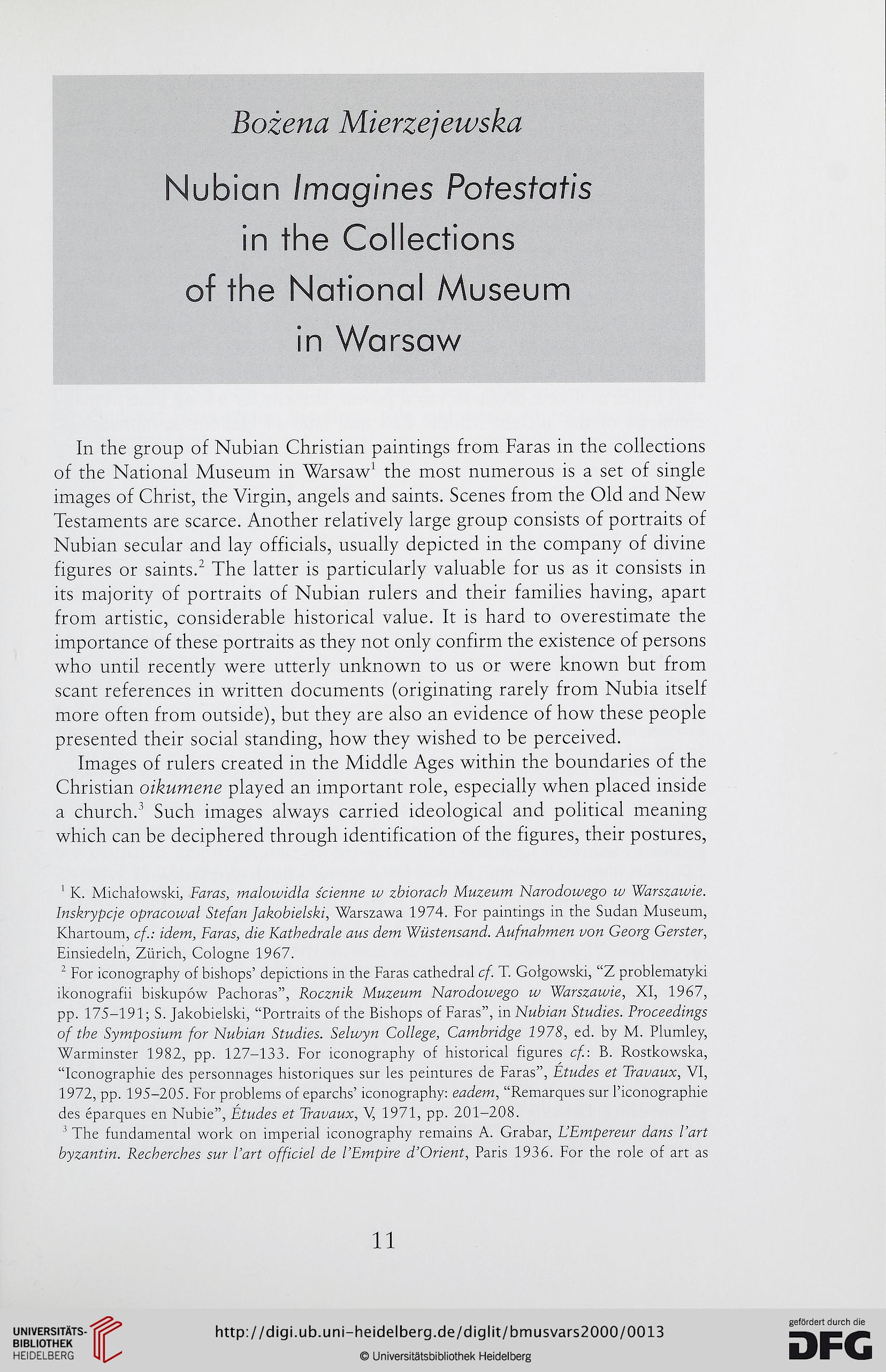Bożena Mierzejewska
Nubian Imogines Potestatis
in the Collections
of the National Museum
in Warsaw
In the group of Nubian Christian paintings from Faras in the collections
of the National Museum in Warsaw1 the most numerous is a set of single
images of Christ, the Virgin, angels and saints. Scenes from the Old and New
Testaments are scarce. Another relatively large group consists of portraits of
Nubian secular and lay officials, usually depicted in the company of divine
figures or saints.2 The latter is particularly valuable for us as it consists in
its majority of portraits of Nubian rulers and their families having, apart
from artistic, considerable historical value. It is hard to overestimate the
importance of these portraits as they not only confirm the existence of persons
who until recently were utterly unknown to us or were known but from
scant references in written documents (originating rarely from Nubia itself
morę often from outside), but they are also an evidence of how these people
presented their social standing, how they wished to be perceived.
Images of rulers created in the Middle Ages within the boundaries of the
Christian oikumene played an important role, especially when placed inside
a church.3 * * * * * * * * Such images always carried ideological and political meaning
which can be deciphered through Identification of the figures, their postures,
1 K. Michałowski, Faras, malowidła ścienne w zbiorach Muzeum Narodowego w Warszawie.
Inskrypcje opracował Stefan Jakobielski, Warszawa 1974. For paintings in the Sudan Museum,
Khartoum, cf.: idem, Faras, die Kathedrale aus dem Wiistensand. Aufnahmen von Georg Gerster,
Einsiedeln, Ziirich, Cologne 1967.
2 For iconography of bishops’ depictions in the Faras cathedral cf. T. Gołgowski, “Z problematyki
ikonografii biskupów Pachoras”, Rocznik Muzeum Narodowego w Warszawie, XI, 1967,
pp. 175-191; S. Jakobielski, “Portraits of the Bishops of Faras”, in Nubian Studies. Proceedings
of the Symposium for Nubian Studies. Selwyn College, Cambridge 1978, ed. by M. Plumley,
Warminster 1982, pp. 127-133. For iconography of historical figures cf.: B. Rostkowska,
“Iconographie des personnages historiąues sur les peintures de Faras”, Etudes et Travaux, VI,
1972, pp. 195-205. For problems of eparchs’ iconography: eadem, “Remarąues sur 1’iconographie
des eparąues en Nubie”, Etudes et Travaux, V, 1971, pp. 201-208.
! The fundamental work on imperial iconography remains A. Grabar, LEmpereur dans Fart
byzantin. Recherches sur Fart officiel de FEmpire d’Orient, Paris 1936. For the role of art as
11
Nubian Imogines Potestatis
in the Collections
of the National Museum
in Warsaw
In the group of Nubian Christian paintings from Faras in the collections
of the National Museum in Warsaw1 the most numerous is a set of single
images of Christ, the Virgin, angels and saints. Scenes from the Old and New
Testaments are scarce. Another relatively large group consists of portraits of
Nubian secular and lay officials, usually depicted in the company of divine
figures or saints.2 The latter is particularly valuable for us as it consists in
its majority of portraits of Nubian rulers and their families having, apart
from artistic, considerable historical value. It is hard to overestimate the
importance of these portraits as they not only confirm the existence of persons
who until recently were utterly unknown to us or were known but from
scant references in written documents (originating rarely from Nubia itself
morę often from outside), but they are also an evidence of how these people
presented their social standing, how they wished to be perceived.
Images of rulers created in the Middle Ages within the boundaries of the
Christian oikumene played an important role, especially when placed inside
a church.3 * * * * * * * * Such images always carried ideological and political meaning
which can be deciphered through Identification of the figures, their postures,
1 K. Michałowski, Faras, malowidła ścienne w zbiorach Muzeum Narodowego w Warszawie.
Inskrypcje opracował Stefan Jakobielski, Warszawa 1974. For paintings in the Sudan Museum,
Khartoum, cf.: idem, Faras, die Kathedrale aus dem Wiistensand. Aufnahmen von Georg Gerster,
Einsiedeln, Ziirich, Cologne 1967.
2 For iconography of bishops’ depictions in the Faras cathedral cf. T. Gołgowski, “Z problematyki
ikonografii biskupów Pachoras”, Rocznik Muzeum Narodowego w Warszawie, XI, 1967,
pp. 175-191; S. Jakobielski, “Portraits of the Bishops of Faras”, in Nubian Studies. Proceedings
of the Symposium for Nubian Studies. Selwyn College, Cambridge 1978, ed. by M. Plumley,
Warminster 1982, pp. 127-133. For iconography of historical figures cf.: B. Rostkowska,
“Iconographie des personnages historiąues sur les peintures de Faras”, Etudes et Travaux, VI,
1972, pp. 195-205. For problems of eparchs’ iconography: eadem, “Remarąues sur 1’iconographie
des eparąues en Nubie”, Etudes et Travaux, V, 1971, pp. 201-208.
! The fundamental work on imperial iconography remains A. Grabar, LEmpereur dans Fart
byzantin. Recherches sur Fart officiel de FEmpire d’Orient, Paris 1936. For the role of art as
11




